Catalog Ads in top-funnel ads and prospecting
April 29, 2025
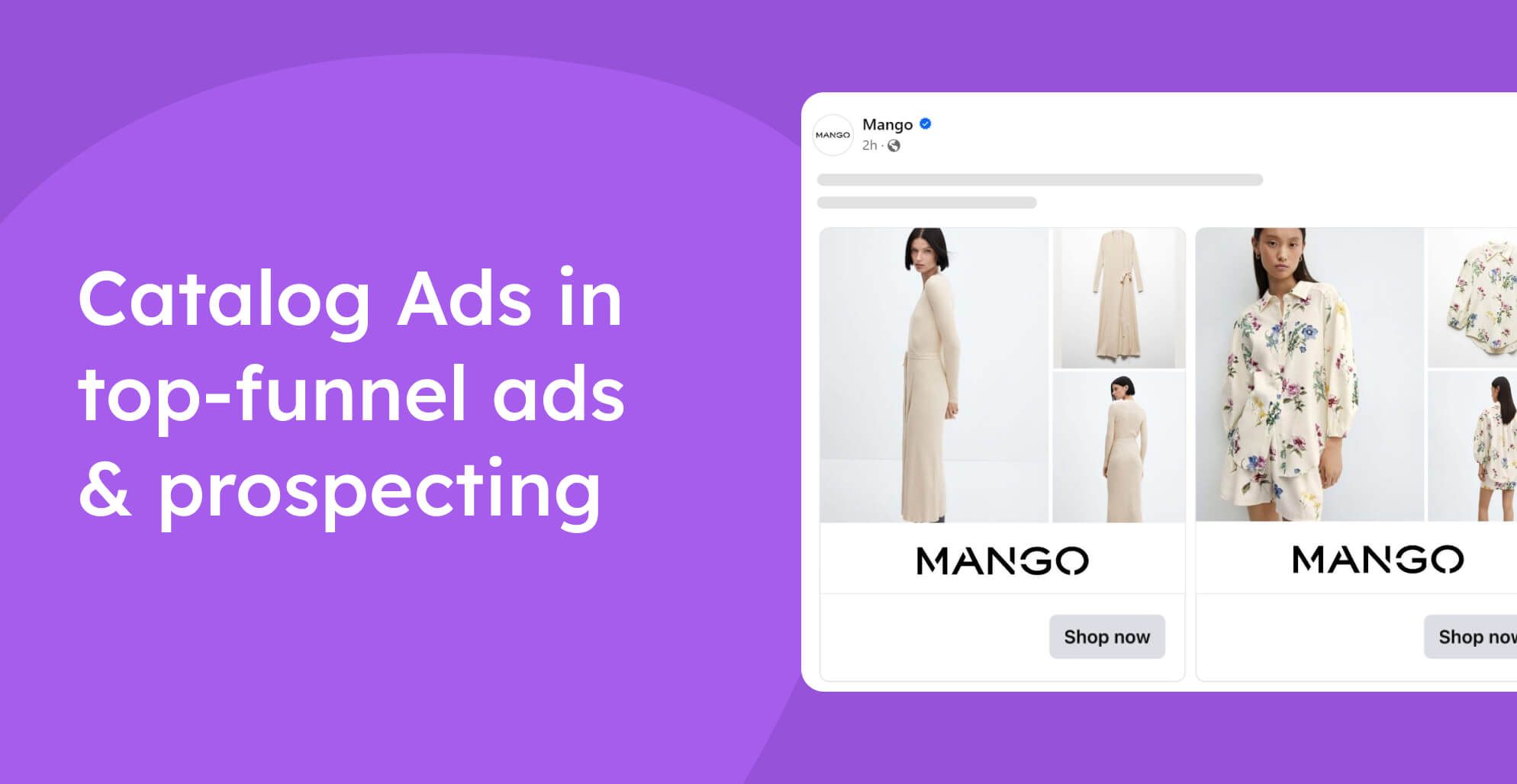
If you’re new to designing Catalog Ads and you have the added challenge of targeting potential new customers at the top of the funnel, you’ve landed on the right page. Not only will you find examples of Catalog Ads variations that you can use, but we also share data-backed findings of what works.
We’ve studied thousands of Catalog Ads designs to figure out how adding (or leaving out) certain information will impact your ads’ performance; especially in your prospecting or DABA campaigns.
And there's a good reason to use Catalog Ads for this - look at how effective Catalog Ads are in the top funnel, compared to normal manual ads:
| Performance of top-funnel ads | Normal ads | Catalog Ads |
|---|---|---|
| ROASReturn On Ad Spend | baseline | +43% |
| CPACost Per Purchase | baseline | -39% |
| CTRClick Through Rate | baseline | +42% |
All the numbers that we share show how Catalog Ads perform on average compared to Catalog Ads without that specific product field. As such, some brands will have better luck including a product field like prices, for example, while, for other brands, this approach will result in a worse performance.
These are average numbers only, but if you take into account our guidance about when it can be a good idea to include which product fields, your Catalog Ads’ performance will be everything but average.
Here you have the insights in a quick cheat sheet - click to get more details:
The most used product fields in Catalog Ads designs:
The moderately used product fields in Catalog Ads designs:
The rarely used product fields in Catalog Ads designs:
Showing Prices in your Catalog Ads
The lower your customer is in your marketing funnel, the better Catalog Ads with prices typically perform compared to Catalog Ads without prices.
- Top-funnel ads see a +31% improvement in Return on Ad Spend when showing prices
- Bottom-funnel ads see a +54% improvement in Return on Ad Spend when showing prices
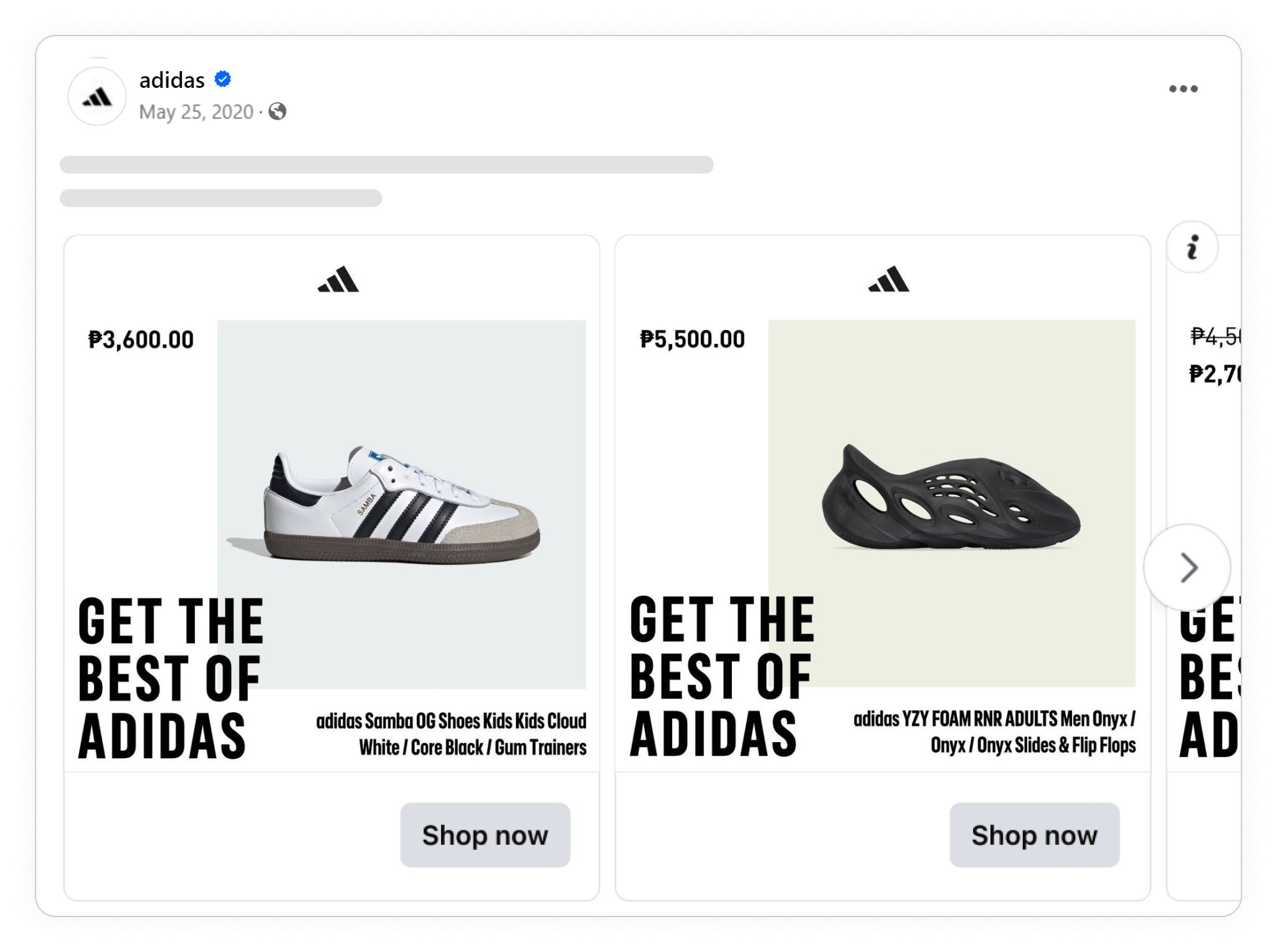
That being said, there’s also a strong case to be made for showing prices in your catalog ads even when you’re trying to target audiences still at the top of the funnel. One of the big benefits of this approach is that it will help you to drive more qualified traffic. It allows you to manage expectations right from the start, decreasing the chance that a potential new customer will bounce as soon as they see your products are way out of their budget.
After all, one of the first things online shoppers check is the price. In fact, it’s a common conception among shoppers that if a price isn’t displayed, the product has to be expensive.
You can learn more about showing prices in your Catalog Ads right here.
Here's how showing prices on average influence Catalog Ads:
Return On Ad Spend
+31%
Cost Per Purchase
-19%
Click Through Rate
-13%
Cost Per Click
-14%
Conversion Rate
-9%
Usage
48%
These numbers show how Catalog Ads showing prices perform on average compared to Catalog Ads not showing prices.
Remember that these are average numbers. For some brands, prices perform better, and for other brands, prices perform worse.
You can learn more about showing prices in your Catalog Ads right here.
Showing your Logo in Catalog Ads
Including your logo in a Catalog Ad is a good idea for eCommerce brands that have already built brand awareness and trust. In this case, it serves as an added trust signal which can help customers at the beginning of their journey to move faster down the funnel.
It’s also a good idea if the product you’re selling is in a competitive niche, because it can quickly set you apart from the dozens of other items available.
That said, even if you haven’t generated massive brand awareness yet, you need to start somewhere. Including your logo in your Catalog Ads is an easy way to start doing just that.
Here’s an example of how you can show your logo in a Catalog Ad:
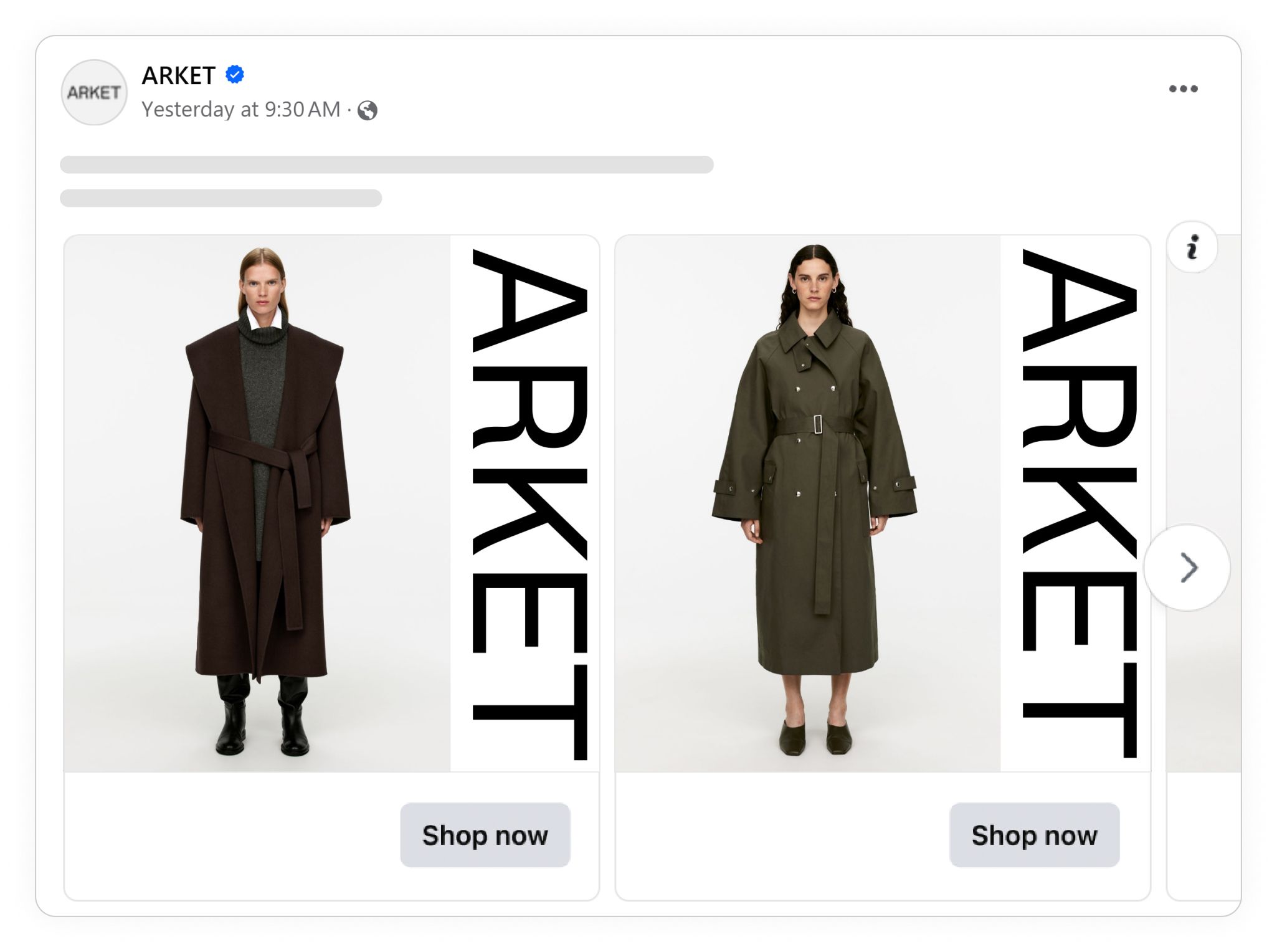
Apart from the dominant focus on the logo, it’s also tilted which helps to let it stand out in the feed. The model images are also very distinct, adding to its overall unique style.
Showing your logo in Catalog Ads typically doesn't improve the performance, but we do see some small changes to this based on your audience. The further down in your funnel you are, the more your logo will typically help close the sale.
- Top-funnel ads, on average, don't see improvements in Return on Ad Spend when showing your logo
- Bottom-funnel ads see a +14% improvement in Return on Ad Spend when showing your logo
You can see more about showing your logo in Catalog Ads here.
Here's how showing your logo on average influence Catalog Ads:
Return On Ad Spend
-0%
Cost Per Purchase
-1%
Click Through Rate
-2%
Cost Per Click
-3%
Conversion Rate
-24%
Usage
37%
These numbers show how Catalog Ads showing the logo of the advertiser perform on average compared to Catalog Ads not showing the logo.
Remember that these are average numbers. For some brands, their logo perform better, and for other brands, their logo perform worse.
However, as mentioned, the real value (which often goes unmeasured) is the brand awareness that you generate.
You can see more about showing your logo in Catalog Ads here.
Showing On-sale designs in your Catalog Ads
Sales more often than not will perform better, even more so in your bottom funnel and retargeting ads making consumers who already know about you very likely to buy.
Even though sales more often than not will perform better, then sales are especially effective in your bottom funnel and retargeting - making consumers that already know about you very likely to buy.
The more bottom-funnel your ad is, the better a sale will work.
- Top-funnel ads see a +39% improvement in Return on Ad Spend when showing on-sale designs
- Bottom-funnel ads see a +68% improvement in Return on Ad Spend when showing on-sale designs
You can see a ton of examples of sales Catalog Ads here, learn more about showing discounts in your Catalog Ads here, and learn more about campaigns in your Catalog Ads here.
Here's how showing on-sale designs on average influence Catalog Ads:
Return On Ad Spend
+39%
Cost Per Purchase
-14%
Click Through Rate
-9%
Cost Per Click
-24%
Conversion Rate
-20%
Usage
35%
These numbers show how Catalog Ads showing on-sale designs perform on average compared to Catalog Ads not showing on-sale designs.
Remember that these are average numbers. For some brands, on-sale designs perform better, and for other brands, on-sale designs perform worse.
That being said, while customers at the top of the funnel are normally just browsing, using on-sale designs in your paid ads can nudge them to move more quickly into the consideration or even purchase phase. Even if it doesn’t get them to act upon a call to action (CTA), it grabs attention quickly. When new leads see an attractive offer, they’re more likely to stop scrolling and take notice.
It also helps your ad to stand out from other ads in the feed. On-sale design can create an immediate value perception and provide a clear incentive to buy from you instead of a competitor.
Here’s an example of how on-sale designs don’t need to be cheap:
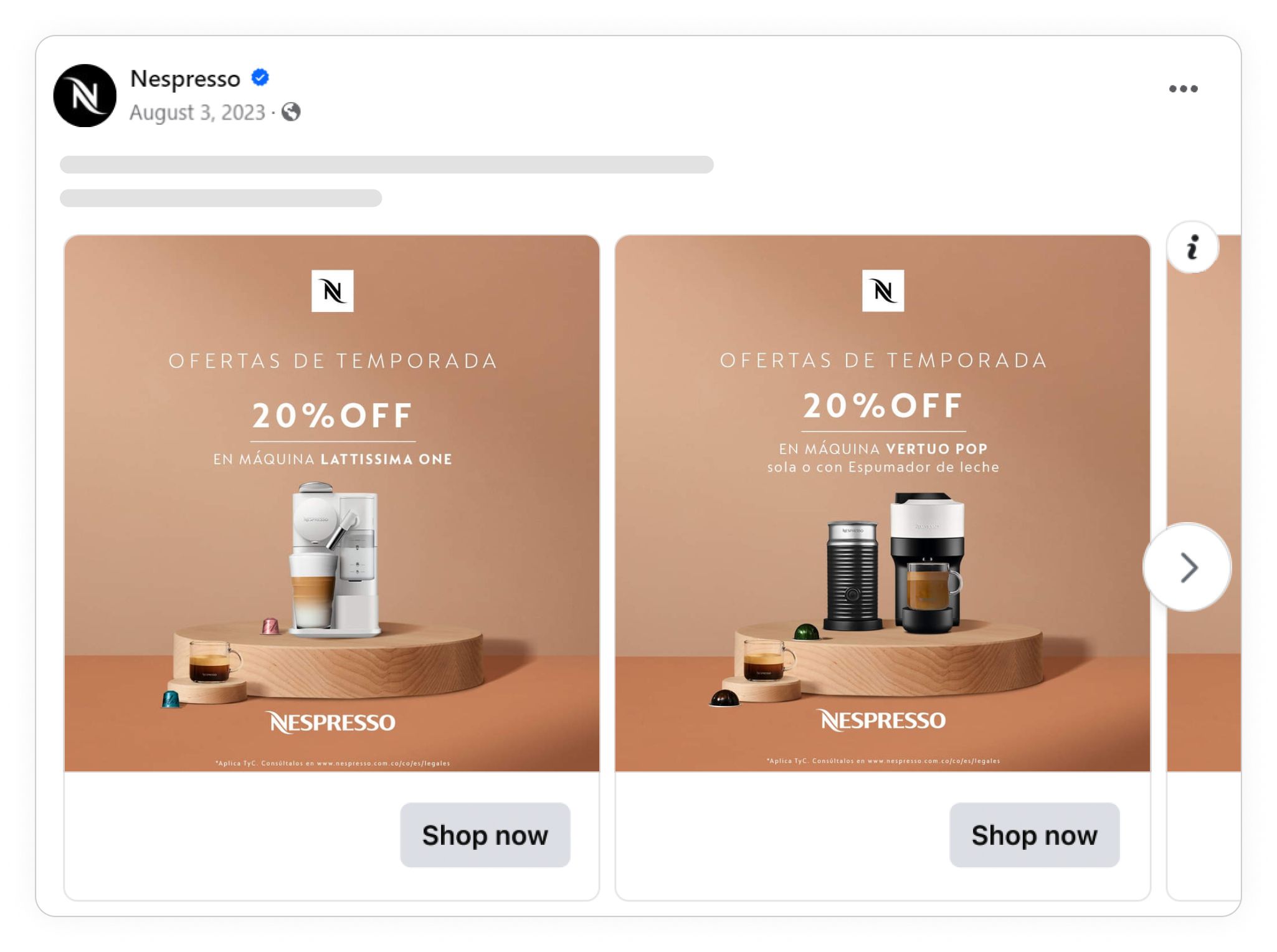
The overall ad is very stylish. In addition to using a high-quality product image, the product is further “elevated” by placing it on a pedestal. It also works well for targeting top-of-the-funnel customers in particular as it offers a lot of information (logo, product name, and a short product description) which new target audiences find important.
You can see a ton of examples of sales Catalog Ads here, learn more about showing discounts in your Catalog Ads here, and learn more about campaigns in your Catalog Ads here.
Showing Product Names in your Catalog Ads
To potential new customers, product names can give immediate context. It also builds product-level awareness as seeing the actual product name along with the image are easier to remember for later when they’re ready to buy.
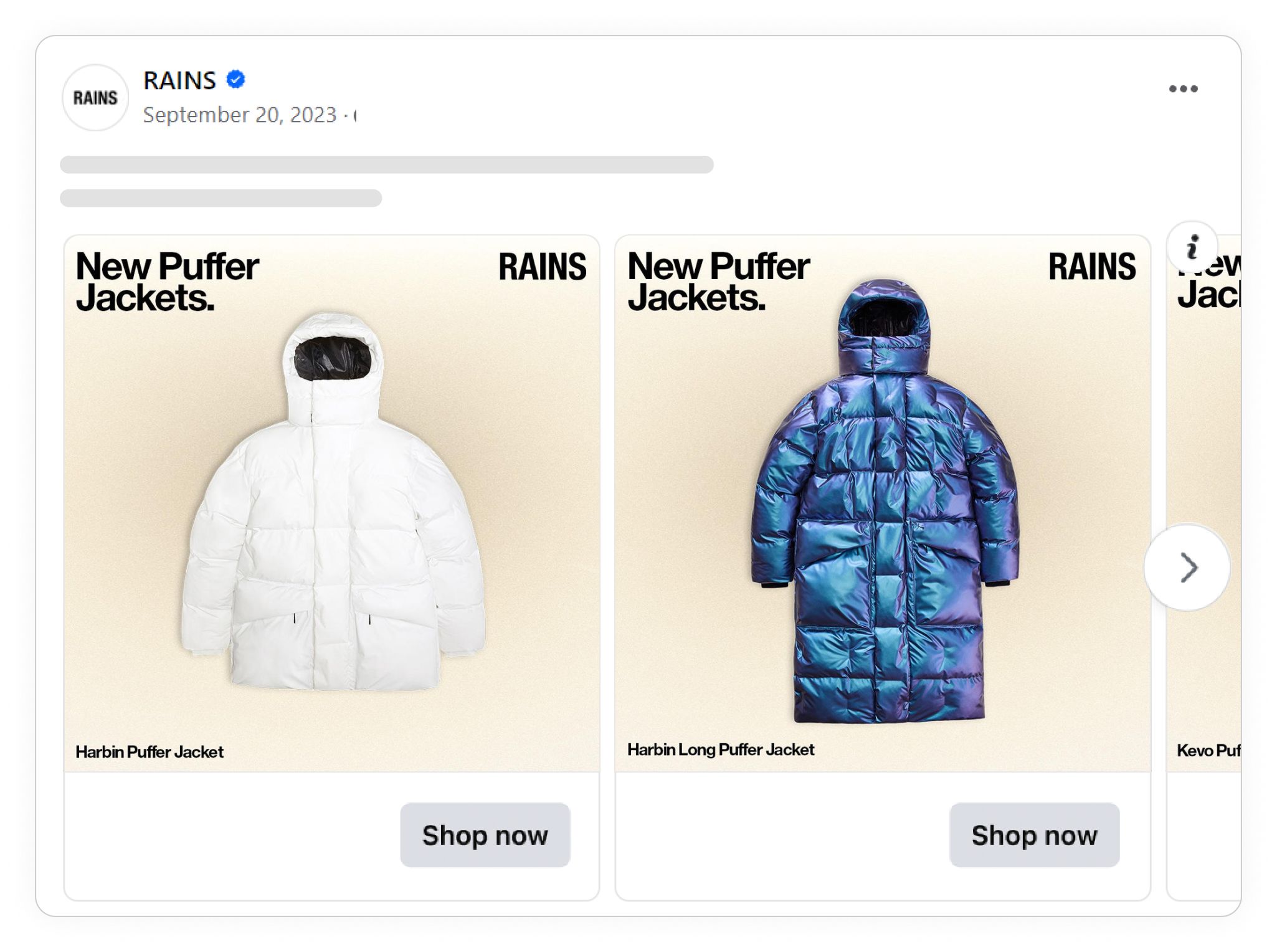
In some instances, including the product names also has a very specific and crucial role to fill. For example, in the case of electronics or food items with exact specifications, the difference between products can’t be explained by a product photo alone. In other words, the difference, such as whether or not it’s vegan-friendly, is only found on “the inside” of the product.
Here's how showing product names on average influence Catalog Ads:
Return On Ad Spend
+1%
Cost Per Purchase
+7%
Click Through Rate
-6%
Cost Per Click
+2%
Conversion Rate
+2%
Usage
33%
These numbers show how Catalog Ads showing product names perform on average compared to Catalog Ads not showing product names.
Remember that these are average numbers. For some brands, product names perform better, and for other brands, product names perform worse.
Look at this ad example, for instance. The product name is there, but it’s not the focus. It’s never going to be the information that sells. This way, RAINS can still promote other features, like product category and logo/brand name, while making it easier for their target audience to find the exact product that they fell in love with later.
You can see more about showing your product names in Catalog Ads here.
Showing Original prices in your Catalog Ads
The price remains a key piece of information that you want to include. If you’re running a sale, it can be a good idea to make space for the original price too. This way, you establish the perceived value of your products among potential new customers who aren’t familiar with your brand yet. In short, it sets a benchmark for value.
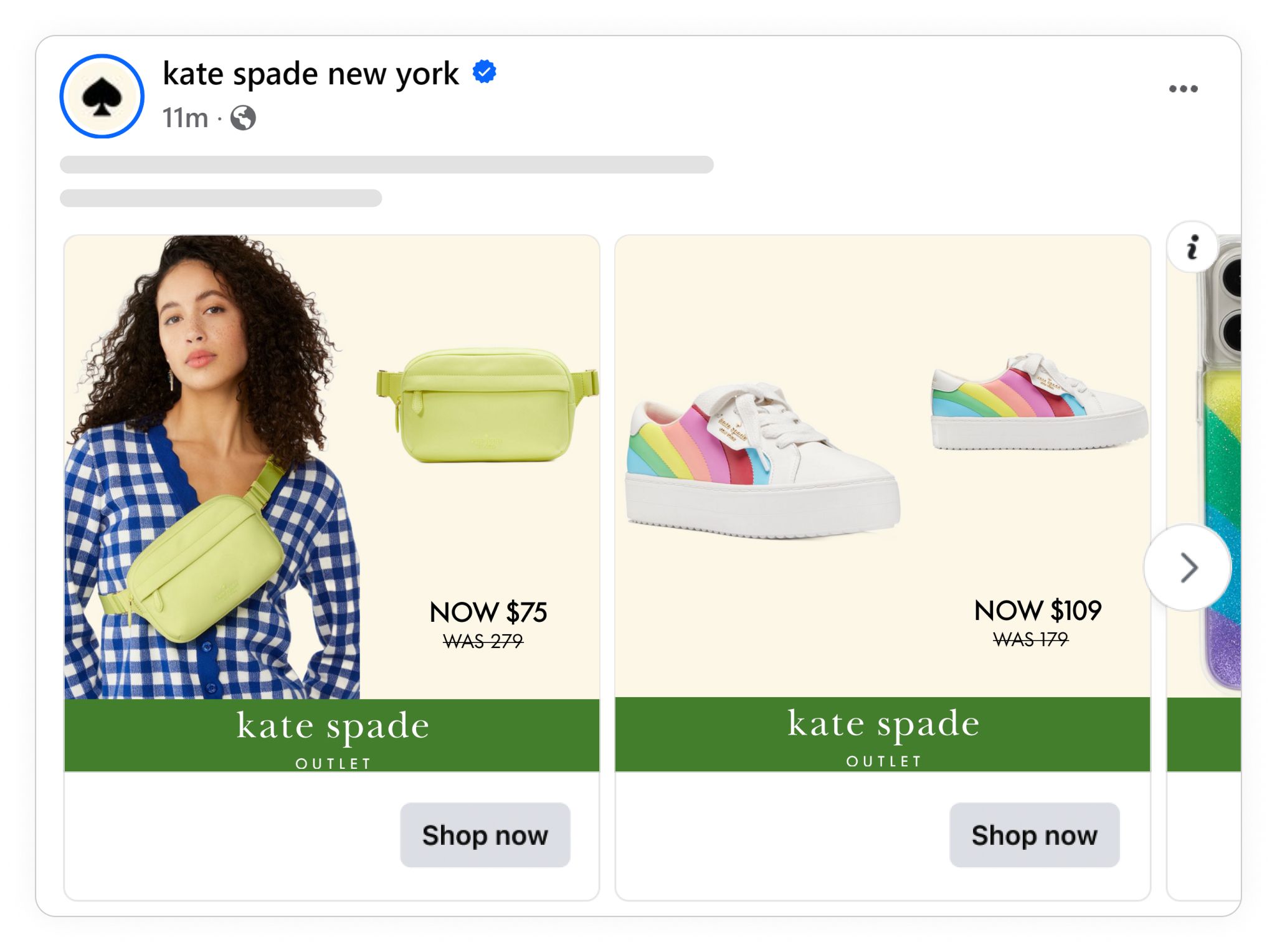
Not only does it show your product’s full worth, but also how “valuable” the new price is. Plus, being upfront about the original price signals honesty which shows to shoppers that you’re transparent, even more crucial when you’re selling online.
Here's how showing original prices on average influence Catalog Ads:
Return On Ad Spend
+19%
Cost Per Purchase
-14%
Click Through Rate
-13%
Cost Per Click
-24%
Conversion Rate
-32%
Usage
25%
These numbers show how Catalog Ads showing original prices perform on average compared to Catalog Ads not showing original prices.
Remember that these are average numbers. For some brands, original prices perform better, and for other brands, original prices perform worse.
Needless to say, when using this strategy, just make sure that you clearly strike out the original price like done in the ad example above to avoid confusion. You can use a similar approach to keep the focus on the current price (which will emphasize the huge savings) and use a mix of product and lifestyle images.
Showing additional images in your Catalog Ads
When you introduce your products for consumers for the first time, you should not reveal too much information about the product. Don’t overwhelm a curios consumer with too many details - you can always do this later.
Additional images of the product is adding more details, in a visual way - and what we see, is that the lower in your funnel the consumer is, the better additional images work.
- Top-funnel ads see a +7% improvement in Return on Ad Spend when showing additional images
- Bottom-funnel ads see a +33% improvement in Return on Ad Spend when showing additional images
You can learn more about showing additional images in your Catalog Ads here.
When adding extra images, double-check that each image adds value. For example, in these Catalog Ads, Mango makes sure to show everything from the full model to the product to a backshot.
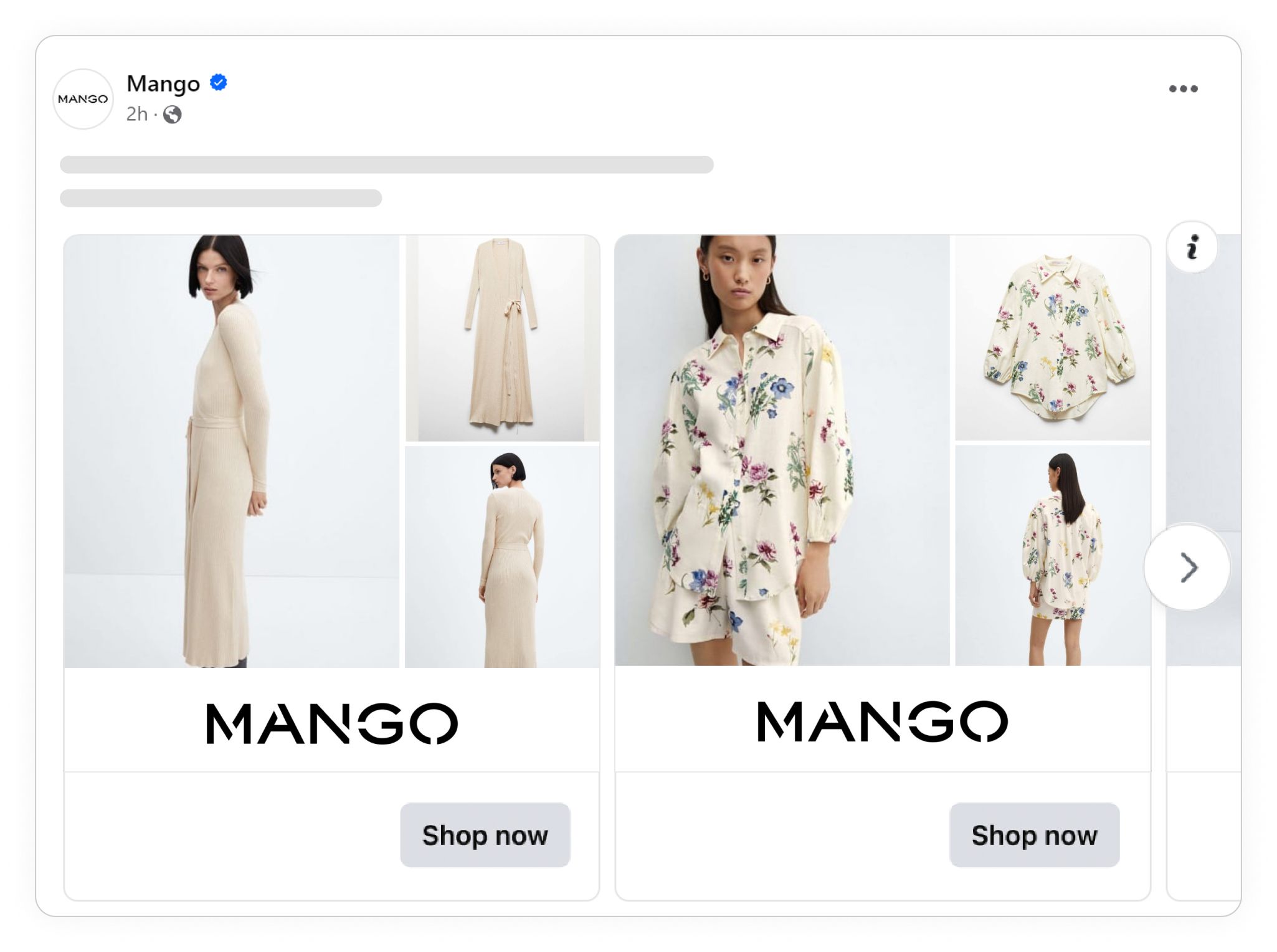
Here's how showing additional images on average influence Catalog Ads:
Return On Ad Spend
+7%
Cost Per Purchase
+25%
Click Through Rate
+3%
Cost Per Click
+7%
Conversion Rate
-12%
Usage
20%
- Top-funnel ads see a +7% improvement in return on ad spend when showing additional images.
- Bottom-funnel ads see a +33% improvement in return on ad spend when showing additional images.
These numbers show how Catalog Ads showing additional images perform on average compared to Catalog Ads not showing additional images.
Remember that these are average numbers. For some brands, additional images perform better, and for other brands, additional images perform worse.
That said, in some instances, additional images have a very necessary task to do. For example, if you’re selling clothing, you’ll want to show what the item looks like from the front and the back, especially if there’s hidden detail on the back like buttons or a bow. Or, if there’s impressive craftsmanship or an extra detail like coloured stitching that makes for a unique feature, it makes sense to make space for an extra image.
You can learn more about showing additional images in your Catalog Ads here.
Showing Savings and Discounts in your Catalog Ads
Similarly to on-sale designs, highlighting savings and discounts help to capture attention and let your ad stand out in a crowded feed.
At the end of the day, price remains a critical factor, even more so for first-time buyers. However, a saving or discount reduces the risk of buying from an unknown seller. Risk aside, it also helps to overcome the initial barrier of unfamiliarity by immediately offering clear value.
Here's how showing savings on average influence Catalog Ads:
Return On Ad Spend
+88%
Cost Per Purchase
-14%
Click Through Rate
-13%
Cost Per Click
-31%
Conversion Rate
-12%
Usage
17%
These numbers show how Catalog Ads showing savings perform on average compared to Catalog Ads not showing savings.
Remember that these are average numbers. For some brands, savings perform better, and for other brands, savings perform worse.
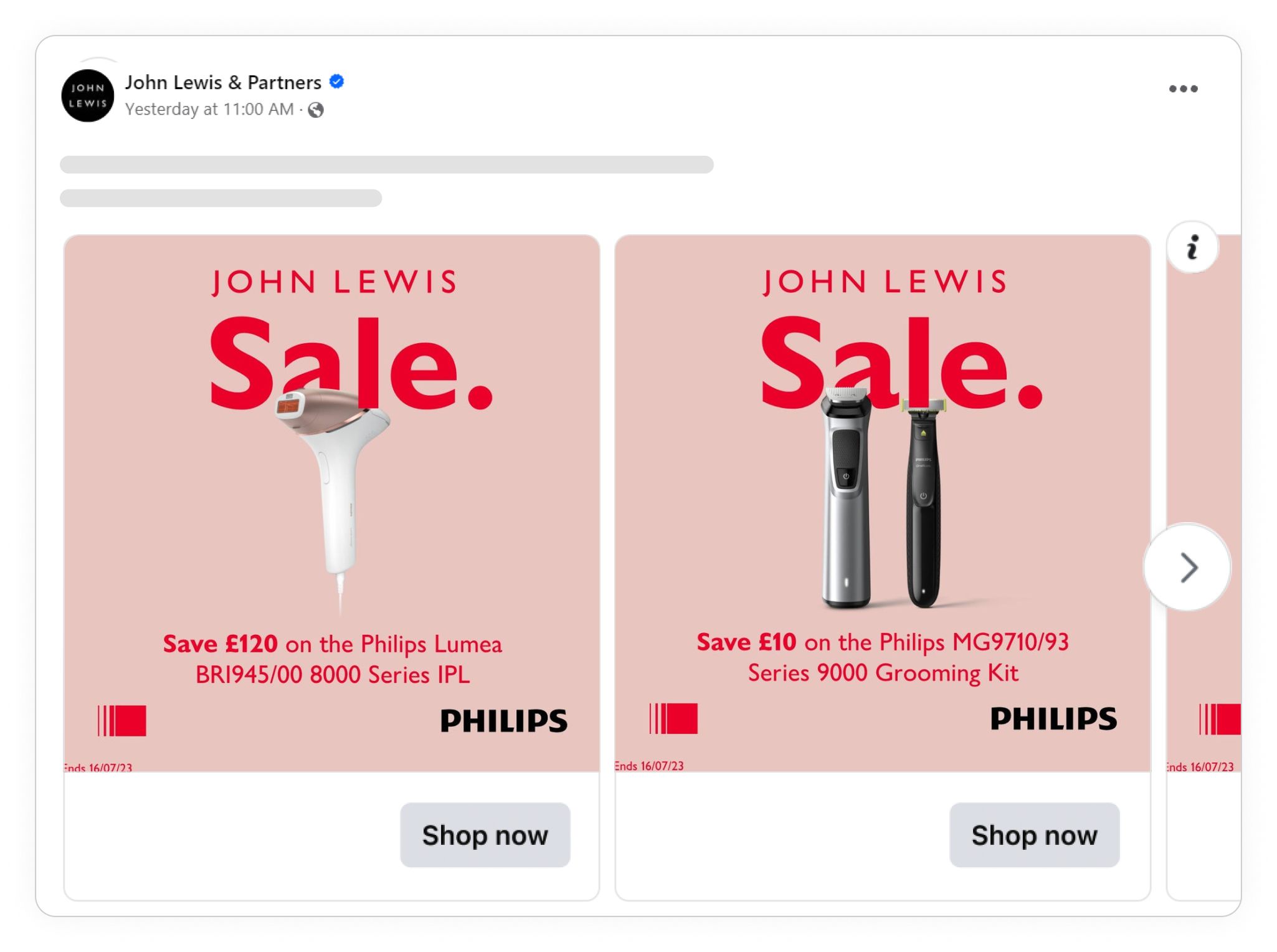
Like with on-sale designs, don’t rely solely on a low price to introduce your product. Sure, you can have the savings in bold, but then back it up with enough extra like your store name, brand name, product name and product description as done in the following ad. Savings and discounts are typically short-lived and can’t be the only reason why new customers should give you a try.
Showing Dates in your Catalog Ads
Dates create urgency and relevance. For example, by including a phrase like “Spring 2025 Collection”, you appeal to new customers who want to see what’s currently relevant. Then, if you change it slightly to “Spring Collection Big Reveal Starts 1 May”, you can create a sense of urgency too, encouraging new leads to act sooner rather than later.
Aside from helping to build urgency, it can also build brand trust. Dates can make your ads feel more legitimate and professional. When people see time-stamped content, it assures them your store is still active. Plus, if it highlights specific dates, it shows that you’re in sync with your target audience which helps to build an emotional connection.
Here's how showing dates on average influence Catalog Ads:
Return On Ad Spend
+27%
Cost Per Purchase
-11%
Click Through Rate
+7%
Cost Per Click
+10%
Conversion Rate
-17%
Usage
21%
These numbers show how Catalog Ads showing dates perform on average compared to Catalog Ads not showing dates.
Remember that these are average numbers. For some brands, dates perform better, and for other brands, dates perform worse.
Here’s how one eCommerce business has used dates in conjunction with sales:
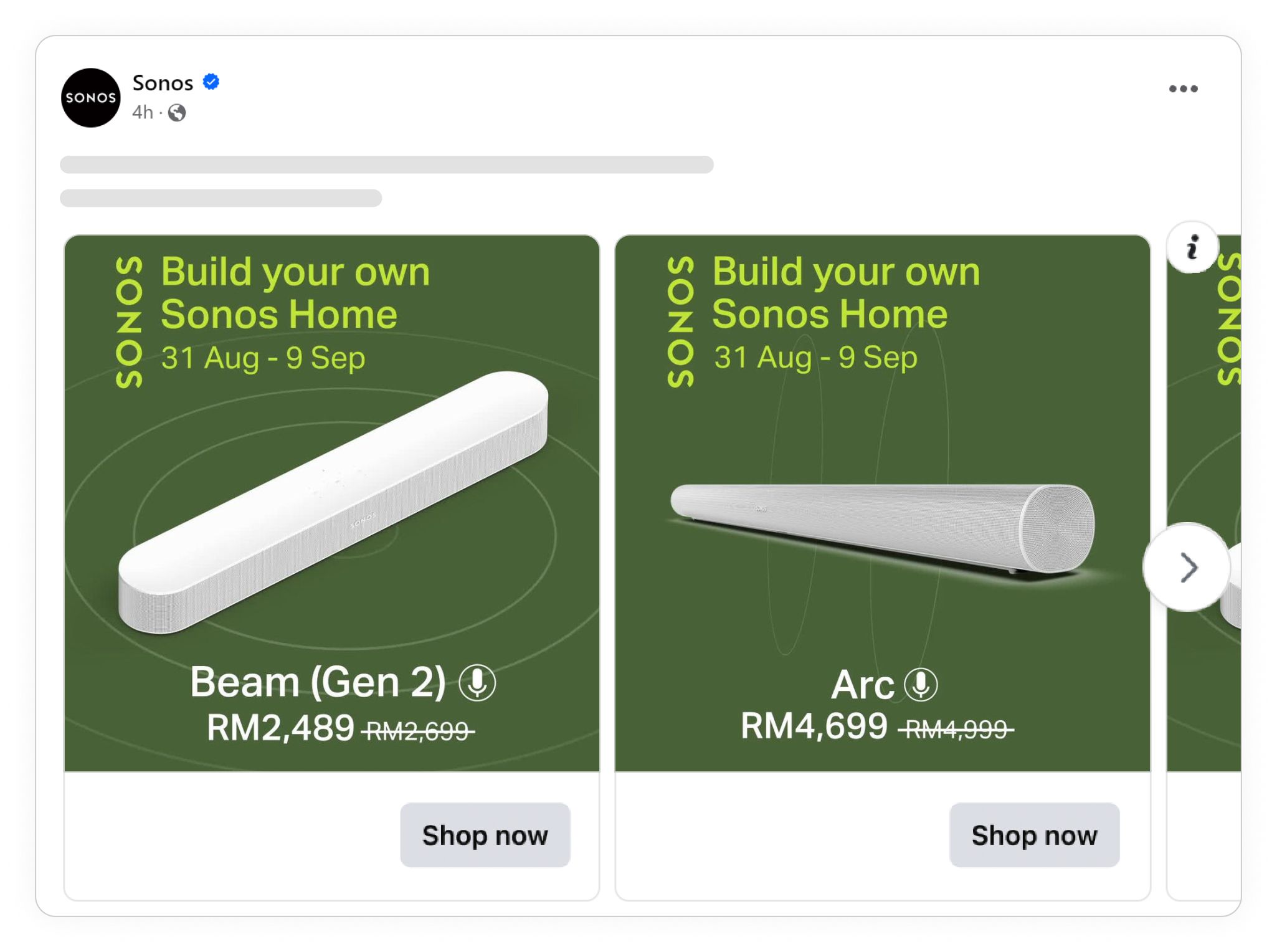
It works because:
It clearly shows when the official promotion period ends, adding urgency and reducing confusion.
It uses splash and product images to create products that stand out in a stylish way.
It manages to include additional information like brand and product name as well as sale price without overwhelming shoppers.
Highlighting News in your Catalog Ads
The word might be short, but it can pack a punch. By including the word “New” in relevant Catalog Ads, you capture attention faster and trigger curiosity among all customers irrespective of where they’re at in their journey.
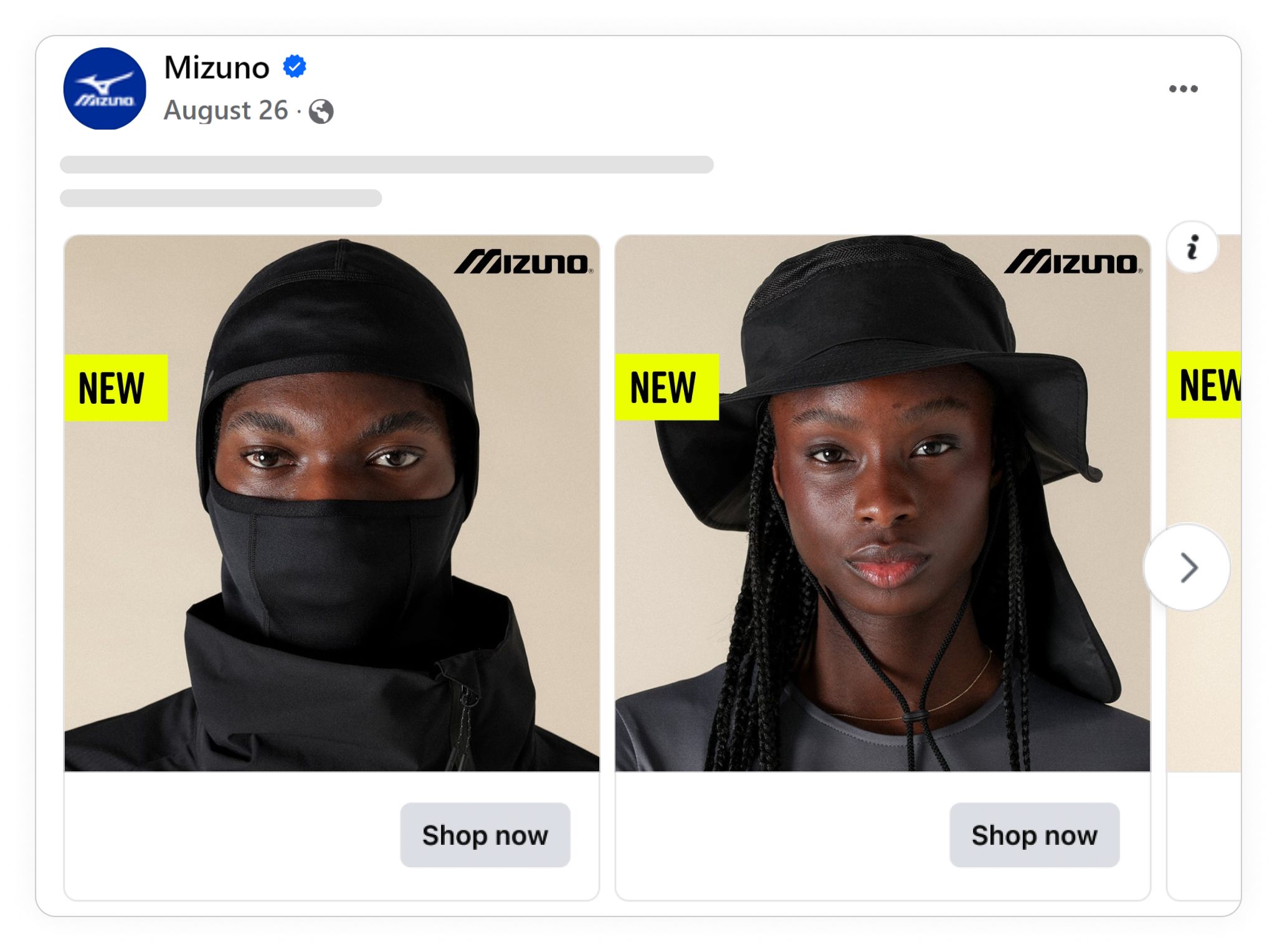
That said, it can be especially effective at reaching customers still at the top of the funnel as they’re actively exploring new options. These shoppers who are unfamiliar with your store will generally be more hesitant to engage, but by inviting them to check out your newest additions they have an incentive to explore further. Plus, it shows that your store is relevant and up-to-date which makes your offering also more appealing to first-time visitors.
Here's how highlighting news on average influence Catalog Ads:
Return On Ad Spend
-5%
Cost Per Purchase
+12%
Click Through Rate
-4%
Cost Per Click
-32%
Conversion Rate
-58%
Usage
19%
These numbers show how Catalog Ads highlighting news perform on average compared to Catalog Ads not highlighting news.
Remember that these are average numbers. For some brands, highlighting news perform better, and for other brands, highlighting news perform worse.
To help you draw even more attention, combine it with a solid background color so that it really stands out in the feed. Then, remember to use high-quality model photos like the ad above to ensure that “newness” isn’t mistaken for lack of quality.
You can learn more about highlighting new products in your Catalog Ads here.
Showing Shipping info in your Catalog Ads
A survey completed in 2024 reveals that delivery cost is more important than speed to American and European online shoppers. What’s more, it can stand in the way of conversion with about four out of 10 of them admitting that they abandoned a cart because the delivery fee was too high. As such, when you plan on displaying shipping info in your Catalog Ads, rather highlight free shipping (if you offer it) than fast delivery.
Sure, your new customers might not be close to entering their delivery address yet, but showing shipping info, like free shipping, reduces purchase friction early on. It can also highlight the added value that you offer upfront and create transparency which helps to reduce skepticism.
Here's how showing shipping info on average influence Catalog Ads:
Return On Ad Spend
+5%
Cost Per Purchase
-27%
Click Through Rate
+6%
Cost Per Click
-40%
Conversion Rate
-7%
Usage
13%
These numbers show how Catalog Ads showing shipping information perform on average compared to Catalog Ads not showing shipping information.
Remember that these are average numbers. For some brands, shipping info perform better, and for other brands, shipping info perform worse.
Here is an example of how showing shipping info in a Catalog Ad will look in practice:
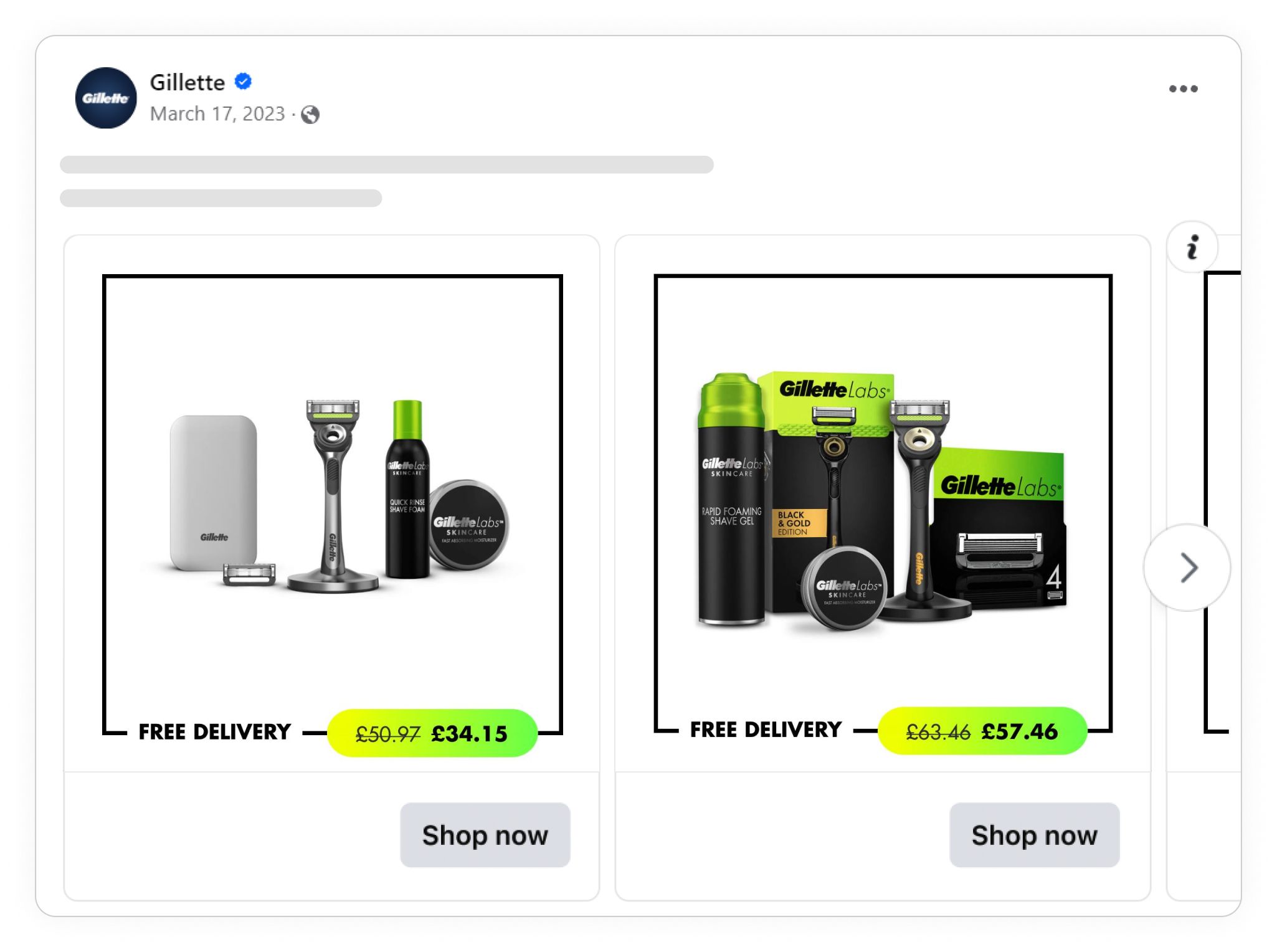
What makes this ad so effective is:
The strategic placing of “free delivery” right next to the price
The very cool use of price splash in the brand colors and using strikethrough "before" price
Opting for a pack shot as well as a bundle.
Using Product Assets in your Catalog Ads
Here's how showing product assets on average influence Catalog Ads:
Return On Ad Spend
+39%
Cost Per Purchase
-29%
Click Through Rate
-4%
Cost Per Click
+18%
Conversion Rate
+48%
Usage
6%
These numbers show how Catalog Ads showing product assets perform on average compared to Catalog Ads not showing product assets.
Remember that these are average numbers. For some brands, product assets perform better, and for other brands, product assets perform worse.
When you use Confect, you have the function to change the product image based on information such as the country of origin. What makes it such an effective feature is that it’s easier for online shoppers to process visuals than text. This way, you can reduce friction early on in the buying journey to increase the chances that a new lead will become a paying customer.
When low prices or exclusivity aren’t features that you can highlight, product assets like the country of origin or an energy efficiency rating can be turned into an attention-grabbing feature.
Here’s an example of how it can look in practice:
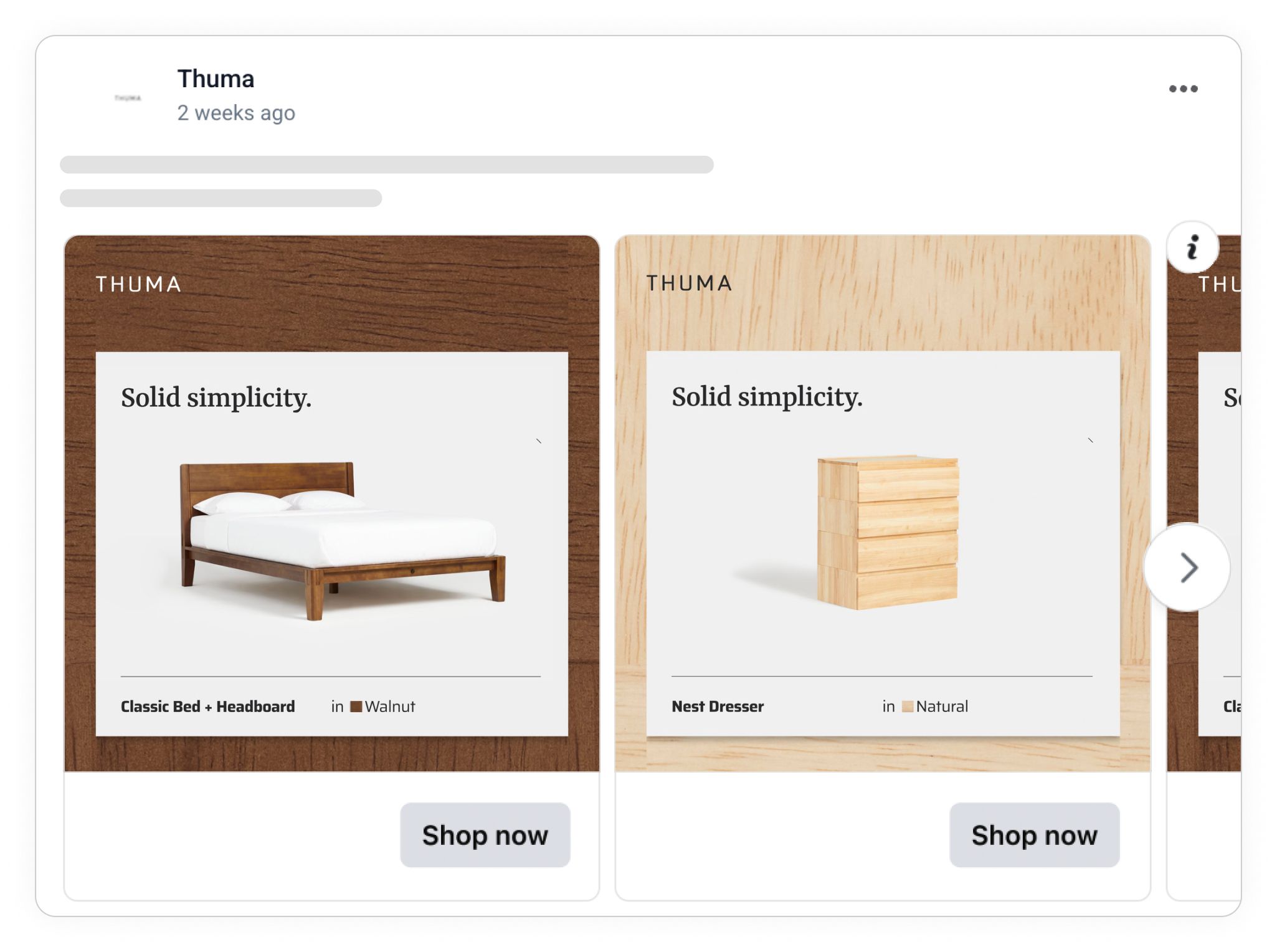
It cleverly uses the product color (an asset of the product) in the design by wrapping the whole design in that color. All in all, it’s just such a stylized, creative way of showing off your products and their assets.
- Very nice use of the product color (an asset of the product) in the design. The whole design is wrapped in that
- Also in the bottom where they write the color name with the box
- It is just such a stylized way of showing off your products and their assets. Very creative!
You can learn more about using product assets in your Catalog Ads here.
Showing Social Proof in your Catalog Ads
Social proof is one of the best-known marketing tactics, and it's more often than not effective at making your customers buy.
Customers who don't know you or your products in particular find a lot of trust in your social proof. Thus, the earlier in your marketing funnel customers are, the more effective social proof is and our numbers back it up:
- Top-funnel ads see a +58% improvement in Return on Ad Spend when showing Social Proof
- Bottom-funnel ads see a +35% improvement in Return on Ad Spend when showing Social Proof
Including social proof like a product review or average star rating in your Catalog Ads can be a great alternative for newer eCommerce brands that don’t have as much brand credibility yet. Seeing that other customers have had a positive experience with your product makes new customers more likely to trust you right away.
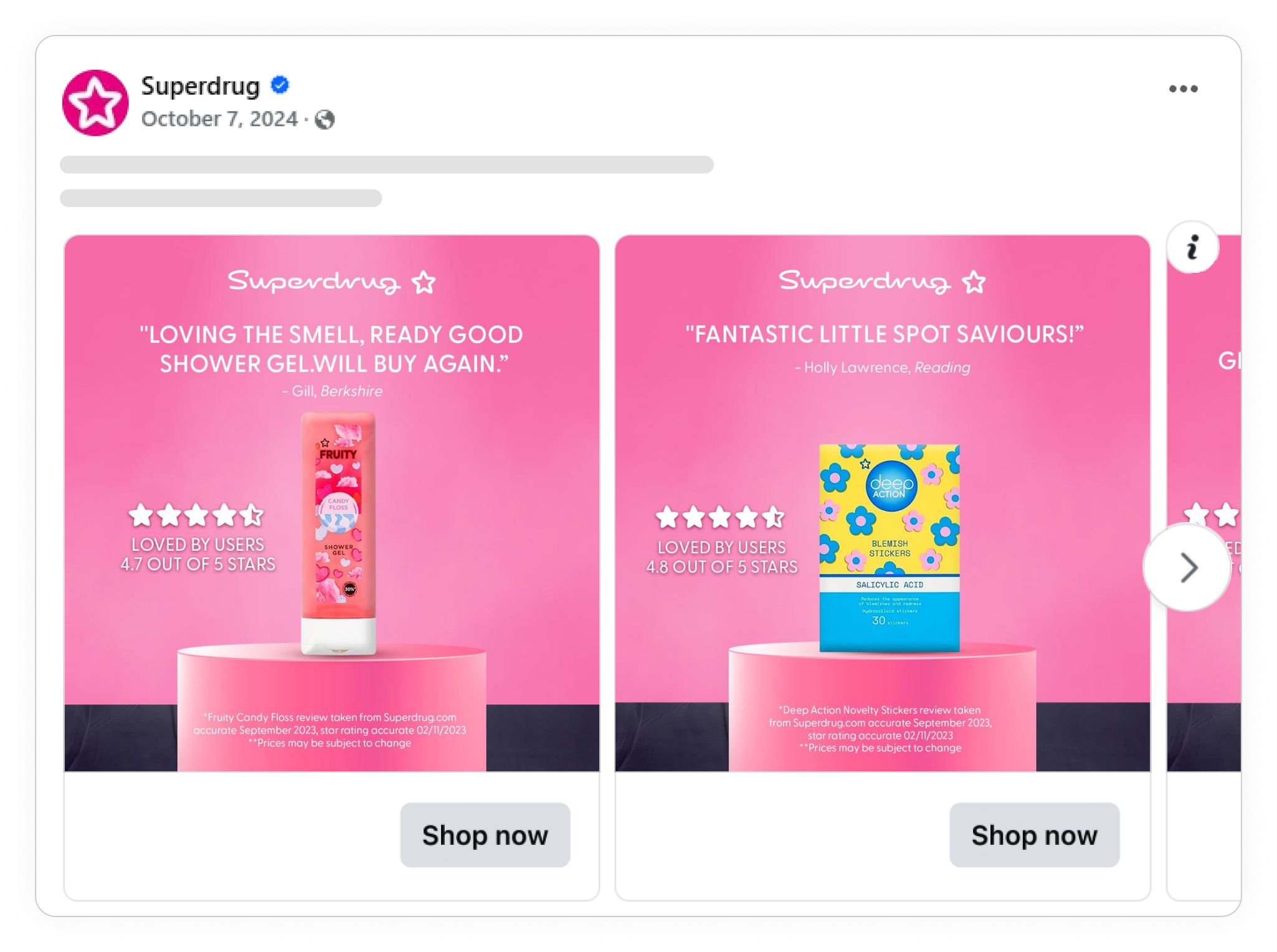
It can also aid the decision-making process, helping to guide potential customers faster down the funnel as rave reviews will give them an indication of what’s currently trending. When customers see that a product is popular, it can even create a sense of urgency. If they don’t buy this product, they’ll be missing out.
You can learn more about showing ratings and reviews in your Catalog Ads right here.
Here's how showing social proof on average influence Catalog Ads:
Return On Ad Spend
+58%
Cost Per Purchase
-29%
Click Through Rate
-21%
Cost Per Click
-9%
Conversion Rate
+53%
Usage
7%
These numbers show how Catalog Ads showing social proof perform on average compared to Catalog Ads not showing social proof.
Remember that these are average numbers. For some brands, social proof perform better, and for other brands, social proof perform worse.
You can learn more about showing ratings and reviews in your Catalog Ads right here.
Showing Product Brands in your Catalog Ads
Including the brand name if it’s produced by a well-known company has the obvious benefit of promising a certain level of satisfaction and quality. Essentially, it makes the transaction less risky, which helps to convert customers that are at the top of the funnel.
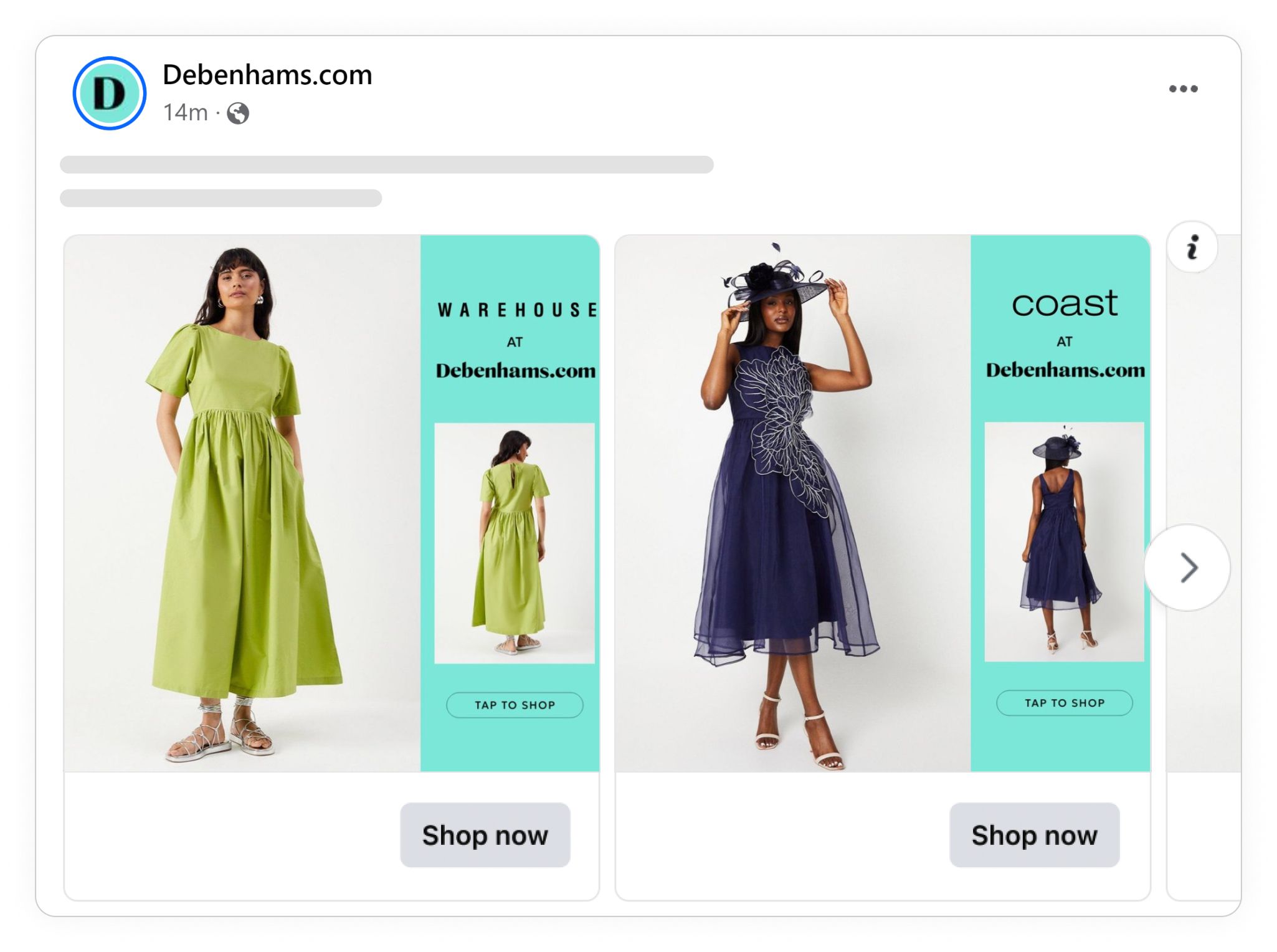
They might be new to your eCommerce store, but they already know the brand behind the product quite well. This way, you can leverage the trust and loyalty that the manufacturer has already built among its customers.
It’s especially effective the more expensive the product is.
Here's how showing brand names on average influence Catalog Ads:
Return On Ad Spend
+31%
Cost Per Purchase
+26%
Click Through Rate
+30%
Cost Per Click
-17%
Conversion Rate
-25%
Usage
6%
These numbers show how Catalog Ads showing brand names perform on average compared to Catalog Ads not showing brand names.
Remember that these are average numbers. For some retailers, brand names perform better, and for other retailers, brand names perform worse.
You can learn more about showing product brands in your Catalog Ads here.
Showing Custom_labels in your Catalog Ads
What makes showing custom information so powerful is that the more consumers learn about you and your products, the more informed they typically want to become. This creates an effect that essentially pulls them further and further down your marketing funnel.
We see this when we look at the numbers. The further down they are in your marketing funnel, the better custom information will perform:
- Top-funnel ads see a +29% improvement in Return on Ad Spend when showing Custom labels
- Bottom-funnel ads see a +73% improvement in Return on Ad Spend when showing Custom labels
Here's how showing custom labels on average influence Catalog Ads:
Return On Ad Spend
+29%
Cost Per Purchase
-4%
Click Through Rate
+2%
Cost Per Click
-37%
Conversion Rate
+0%
Usage
9%
Showing Catalog Ads with custom labels to new customers at the top of the funnel also helps them to see a curated selection that highlights your top-performing products that will leave a stronger first impression and pique their curiosity. The more curious they are, the more likely they'll click to learn more.
The following Catalog Ads serve as a good example of how to add custom labels without adding clutter:
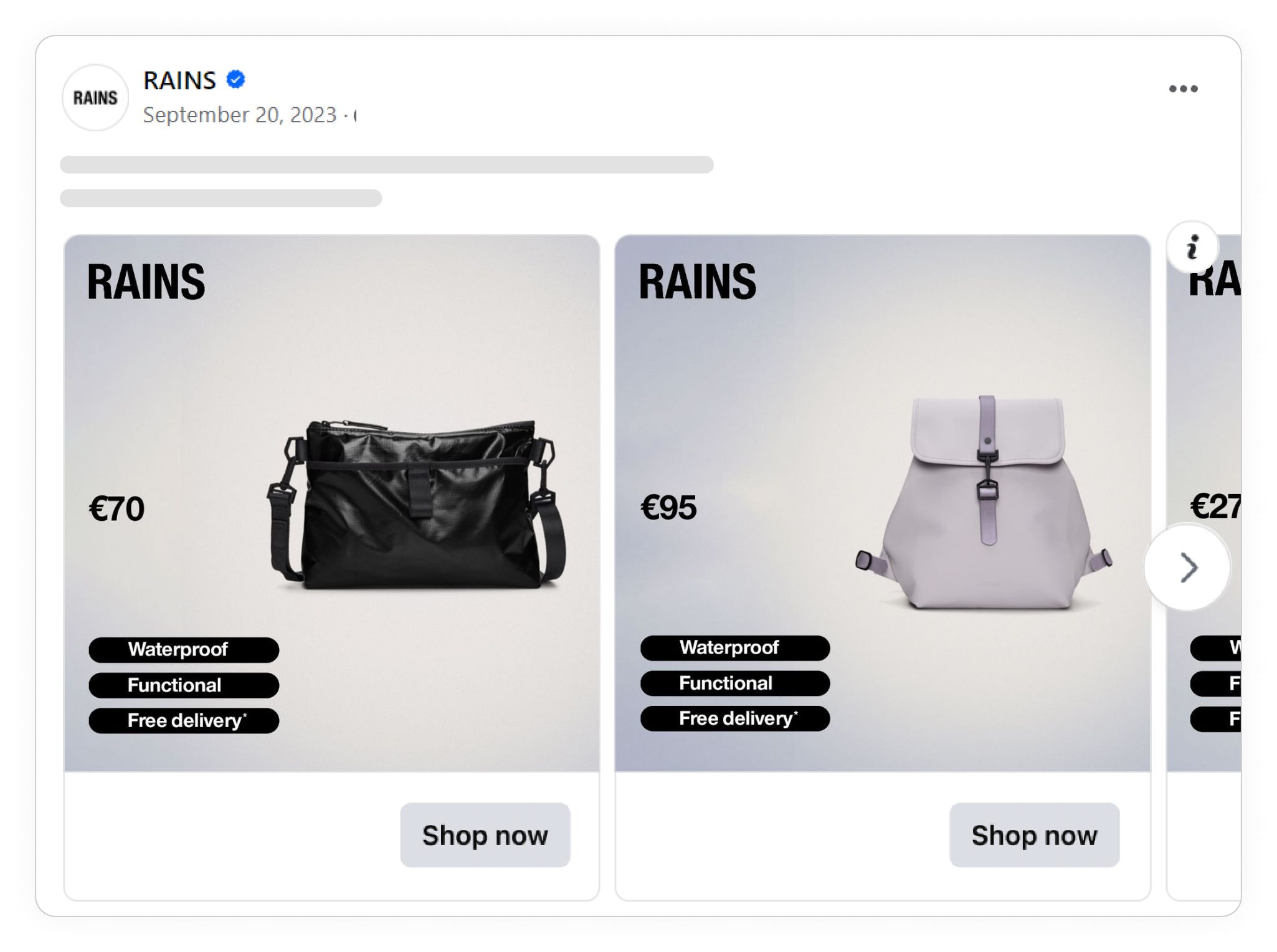
It works, because:
The stylized background draws attention to the product image.
The custom labels focus on promoting the core functionality of the individual products.
These numbers show how Catalog Ads showing custom labels perform on average compared to Catalog Ads not showing custom labels.
Remember that these are average numbers. For some brands, custom labels perform better, and for other brands, custom labels perform worse.
You can learn more about showing custom attributes and features in your Catalog Ads here .
Showing Categories in your Catalog Ads
Including categories in your Catalog Ads might sound like a waste of valuable space, but it’s perfectly positioned for new customers who don’t know your brand and its product range yet. This way, you can cast your wide net which increases the likelihood that they’ll find something that they need or interests them.
It doesn’t necessarily need to be purely based on the different types of products that you sell like footwear, accessories, or swimwear, for example. You can also feature categories such as “New Arrivals”, “Gifts Under $100”, or “Last of the Bestsellers”. This approach helps to appeal to different shopping preferences, helping to make your ads more relevant to a bigger audience.
After all, the goal of top-of-the-funnel ads is to grow awareness and interest. Basing your ads on categories helps to introduce your product range in a structured way that sets the foundation upon which future engagement can be built.
Here's how showing product categories on average influence Catalog Ads:
Return On Ad Spend
+131%
Cost Per Purchase
-34%
Click Through Rate
+0%
Cost Per Click
-10%
Conversion Rate
+132%
Usage
3%
These numbers show how Catalog Ads showing categories perform on average compared to Catalog Ads not showing categories.
Remember that these are average numbers. For some brands, categories perform better, and for other brands, categories perform worse.
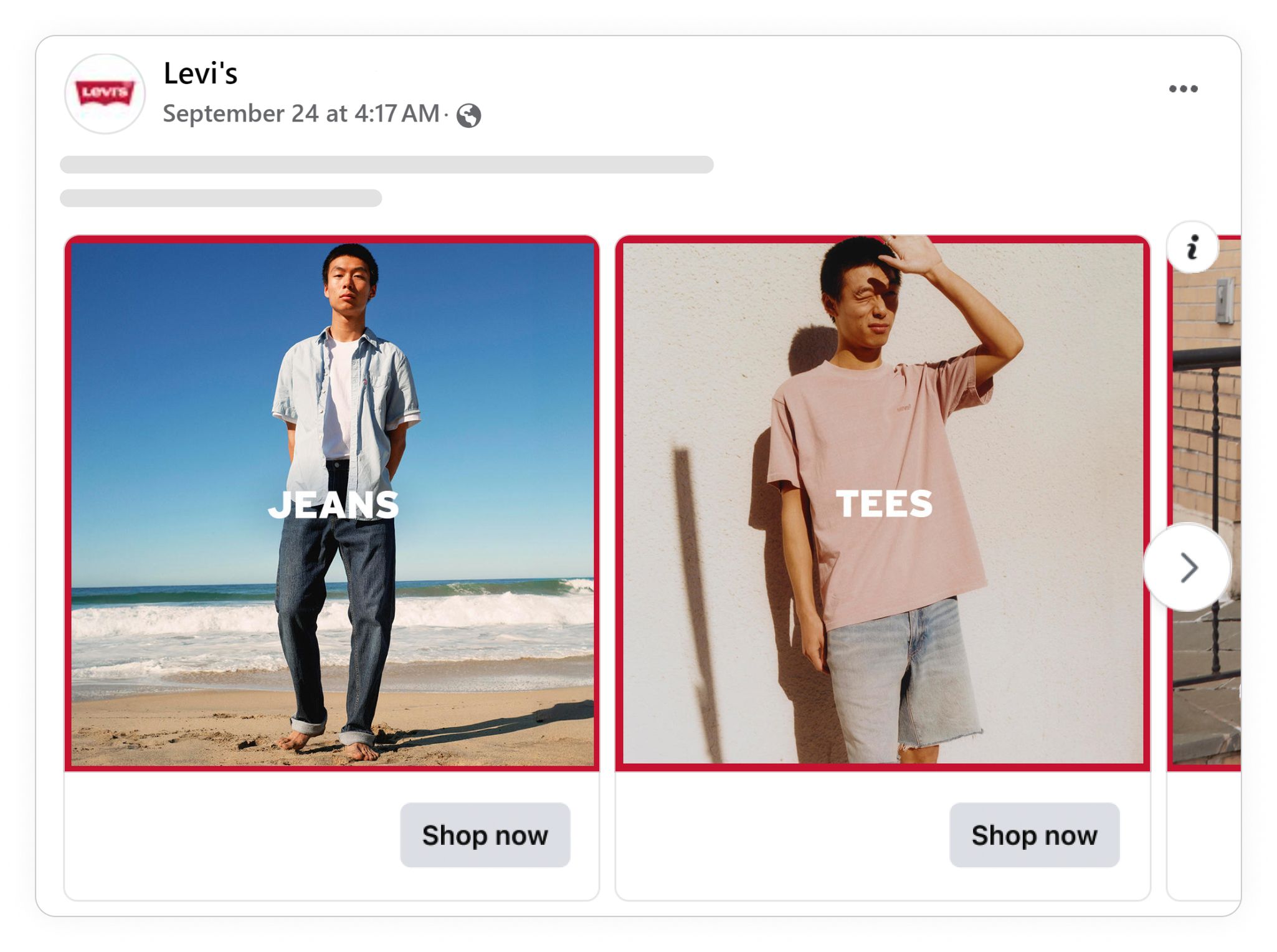
For an example of how to run category-based ads, you can take a look at what Levi’s has done. The brand is synonymous with jeans, but they also sell other clothing items like T-shirts. Their Catalog Ads work because:
Its simplistic design puts the focus on the category.
It includes beautiful images to show off the product category.
They subtly incorporate their iconic brand color around the edge to reinforce brand recognition.
Showing Product Descriptions in Catalog Ads
If you have a very unique product, you’ll want to highlight it in your Catalog Ads. For example, if your target audience is eco-friendly consumers, descriptions like “made from recyclable material” or “100% plant-based” are the type of information that they’re searching for.
Perhaps you have a few similar products? In this case, incorporating parts of the product description will also help to distinguish your different items, helping new customers to select the one that will best address their pain point.
The secret to incorporating product descriptions successfully in your Catalog Ads is to focus on relevance. Customers at the top of the funnel are just becoming aware of your different products and you want to highlight the features that they’ll find the most appealing to avoid information overload.
Here's how showing descriptions on average influence Catalog Ads:
Return On Ad Spend
+116%
Cost Per Purchase
-15%
Click Through Rate
+51%
Cost Per Click
-34%
Conversion Rate
-80%
Usage
1%
These numbers show how Catalog Ads showing descriptions perform on average compared to Catalog Ads not showing descriptions.
Remember that these are average numbers. For some brands, descriptions perform better, and for other brands, descriptions perform worse.
To avoid that your Catalog Ads become text-heavy, you can follow this example:
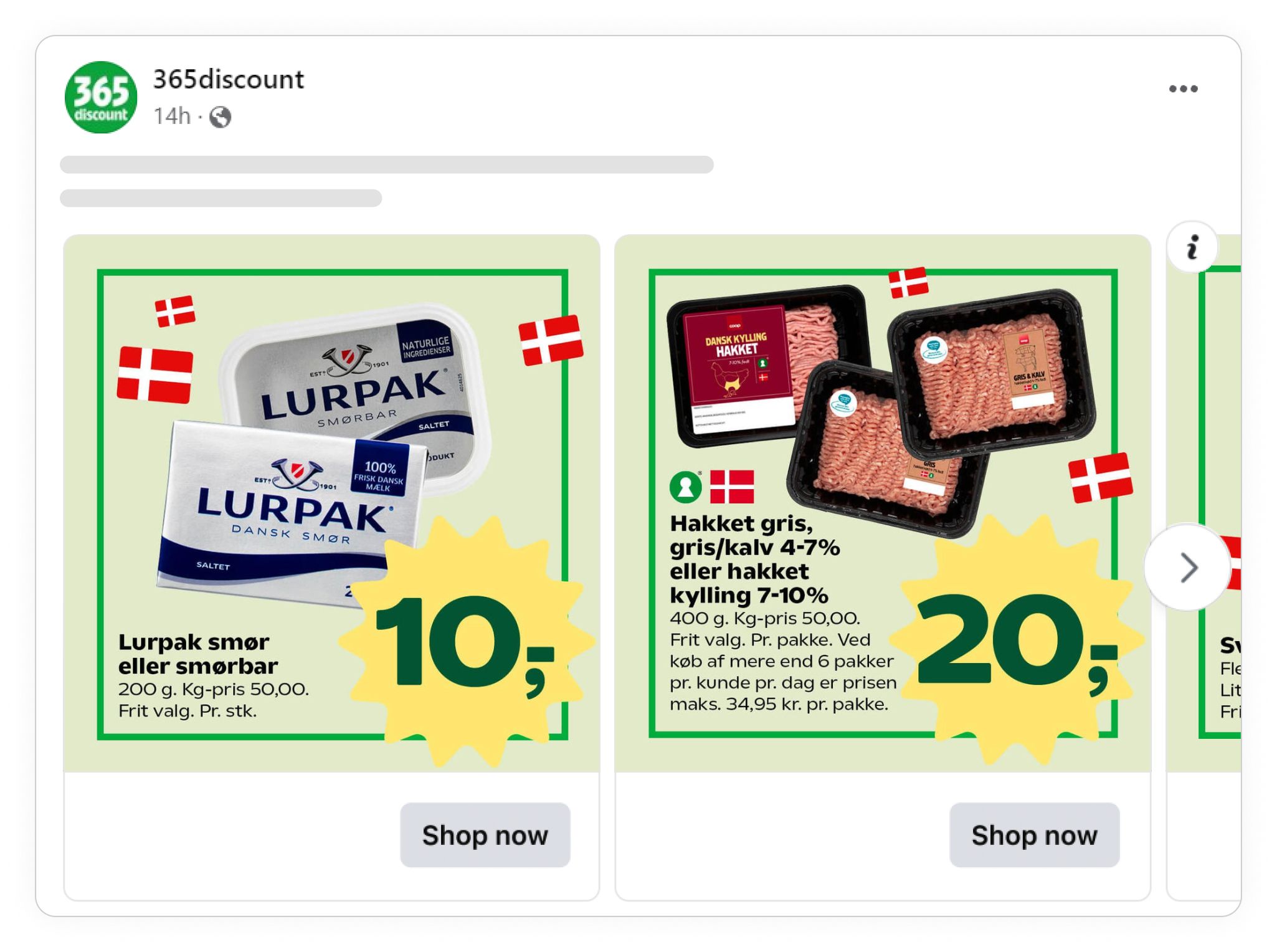
The product description only highlights the most important information, while the nice use of background image and framing spices up an otherwise boring product.
- Very nice use of product description to write out the important information
- Very nice use of background image and framing to spice up an otherwise boring product
Final thoughts
From prices to product names to descriptions to dates, there are various ways that you can improve your top-of-the-funnel ads to reach broad audiences. Sure, any eCommerce brand wants (and needs) loyal customers, but you also need to grow your audience actively. That’s how you build a sustainable online business.
While Catalog Ads display products in a visually engaging way. Adding a different element like a brand name or logo or highlighting a reduced price can have a significant psychological impact on consumers. Whether it’s to create a sense of urgency or a fear that they’ll be missing out or simply to serve as social proof, you need more than a single static product photo.
As there are various elements that you can add, make A/B testing part of your design process. For example, what is the effect when you combine social proof with shipping info? Perhaps you get better results if you pair dates with star ratings? If new customers can be open-minded to try products unknown to them, you too can change up your Catalog Ads.
Bookmark this page by pressing ctrl + D / cmd + D, or by clicking the star icon in your URL bar ⭐️.
